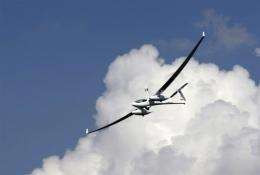World's first as fuel cell aircraft takes off in Germany

The world's first piloted aircraft capable of taking to the air using only power from fuel cells took off in Germany Tuesday, producing zero carbon dioxide emissions, its makers said.
"We have improved the performance capabilities and efficiency of the fuel cell to such an extent that a piloted aircraft is now able to take off using it," said Johann-Dietrich Woerner from the German Aerospace Center (DLR).
"This enables us to demonstrate the true potential of this technology, also and perhaps specifically for applications in the aerospace sector," he said.
Developed by the DLR, Lange Aviation, BASF Fuel Cells and Denmark's Serenergy, the Antares DLR-H2 motor glider has a range of 750 kilometres (465 miles) and can fly for five hours.
The system uses hydrogen as its fuel, and this is converted into electrical energy in a direct, electrochemical reaction with oxygen in the ambient air, without any combustion occurring.
The only by-product is water, and if the hydrogen fuel is produced using renewable energy sources, then the motor glider is genuinely CO2-free, the DLR said.
"Although the fuel cell may still be a long way from becoming the primary energy source for the propulsion of commercial aircraft, it does already constitute an interesting and important alternative to existing energy systems as a form of reliable on-board power supply," the DLR said.
(c) 2009 AFP















